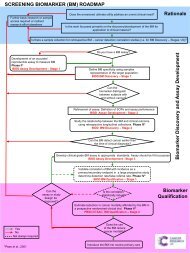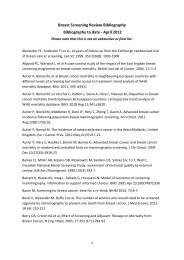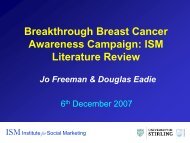Front of pack nutrition labelling for pre-packed foods - Cancer ...
Front of pack nutrition labelling for pre-packed foods - Cancer ...
Front of pack nutrition labelling for pre-packed foods - Cancer ...
You also want an ePaper? Increase the reach of your titles
YUMPU automatically turns print PDFs into web optimized ePapers that Google loves.
<strong>Cancer</strong> Research UK submission to the FSA consultation on <strong>Front</strong> <strong>of</strong><strong>pack</strong> (FOP) <strong>nutrition</strong> <strong>labelling</strong> <strong>for</strong> <strong>pre</strong>-<strong>pack</strong>ed <strong>foods</strong> sold through retailoutlets in the UK3 rd November 2009Background in<strong>for</strong>mation<strong>Cancer</strong> Research UK is the world’s largest independent organisation dedicated tocancer research; in 2007/2008 our total scientific spend was £333 million. Our visionis that ‘Together we will beat cancer’. We carry out world-class research to improveour understanding <strong>of</strong> cancer and to find out how to <strong>pre</strong>vent, diagnose and treatdifferent types <strong>of</strong> the disease. One <strong>of</strong> our priorities is the reduction <strong>of</strong> cancerinequalities. We welcome the opportunity to respond to this inquiry.<strong>Cancer</strong> is a major cause <strong>of</strong> illness with more than 290,000 people diagnosed eachyear in the UK. It is also the biggest cause <strong>of</strong> death in the UK, accounting <strong>for</strong> morethan 1 in 4 deaths or 155,000 deaths in the UK each year. There are significantinequalities in cancer incidence, mortality and survival. The risk <strong>of</strong> being diagnosedwith certain types <strong>of</strong> cancer is greater among the most deprived groups. In addition,although cancer survival rates have been improving since the 1970s, the survival gapbetween the most and least affluent has been increasing.In the response below, we have focused our ef<strong>for</strong>ts where we feel our expertise isstrongest. We have there<strong>for</strong>e not answered question 3 as we feel that others arebetter placed to comment.General commentsClear and accurate food <strong>labelling</strong> can help people to make healthy dietary choicesmore easily and to that effect <strong>Cancer</strong> Research UK supports the use <strong>of</strong> front <strong>of</strong> <strong>pack</strong>food <strong>labelling</strong>, based on the Food Standards Agency’s recommended principles.The current FSA work provides a significant opportunity to create a single integrated<strong>labelling</strong> scheme which will be helpful <strong>for</strong> consumers. We hope that the scheme willfulfil an additional role <strong>of</strong> further educating the public about the <strong>nutrition</strong>al value <strong>of</strong>food products and how they contribute to a healthy diet.We are, however, particularly concerned about the list <strong>of</strong> food products it is proposedwould be excluded from the front <strong>of</strong> <strong>pack</strong> <strong>labelling</strong> scheme. Some <strong>of</strong> the productsincluded in the exemption list can be high in salt content, contain high levels <strong>of</strong>saturated fat or sugar. We would urge the FSA to reconsider the list <strong>of</strong> exemptionswith a view to including the current list in the FOP scheme to ensure that consumersare assisted with clear and com<strong>pre</strong>hensive in<strong>for</strong>mation to help in<strong>for</strong>m healthierchoices.Question 1:
We welcome your views on the range <strong>of</strong> <strong>foods</strong> to which an integrated FOP labelshould be applied, including suggestions <strong>for</strong> a limited number <strong>of</strong> exemptions(paragraph 20).We are concerned about the list <strong>of</strong> exemptions contained on page 7 and 8 <strong>of</strong> theconsultation document and would welcome further in<strong>for</strong>mation about some <strong>of</strong> thecategories. In particular we would welcome in<strong>for</strong>mation about the definition <strong>of</strong> <strong>foods</strong>sold in <strong>pack</strong>ages with small surface areas. We are concerned that this couldpotentially include <strong>foods</strong> which are energy dense or contain a high salt content.We are also concerned that bacon and ham are included in the list <strong>of</strong> exemptions asthese <strong>foods</strong> can be high in salt content. There is a clear link between processed meatand bowel cancer. Some bacon and ham products are high in salt content and<strong>Cancer</strong> Research UK recommends that they should not be included in theexemptions category.We are also concerned that some dairy products are included in the exemptionscategory as some yoghurts can be high in fat. Consumers have also stated that theyare particularly confused about the composition <strong>of</strong> yoghurt products as they cansometimes contain high levels <strong>of</strong> saturated fat and calories and also because someproducts are marketed and promoted as being good <strong>for</strong> digestive health.We would welcome further in<strong>for</strong>mation about what would be included in the categoryentitled ‘fresh and minimally processed fruits’ and in particular there needs to be aclear definition <strong>of</strong> ‘minimally processed fruits’. Particular caution needs to beexercised around fruit juice drinks as these can sometimes contain high levels <strong>of</strong>sugar. There is clear evidence about the links between sugary drinks and obesity andit is because <strong>of</strong> this that we would welcome further in<strong>for</strong>mation about the types <strong>of</strong>food which would be included in this category.Question 2:We welcome your views on the proposal <strong>for</strong> including calories in an integratedFOP label (paragraph 27), and that inter<strong>pre</strong>tive elements should not beincluded.Obesity is the leading cancer risk factor <strong>for</strong> non smokers. We there<strong>for</strong>e believe thatevery ef<strong>for</strong>t should be taken to help the population <strong>pre</strong>vent obesity and to managethe condition where necessary and we agree with the proposal <strong>for</strong> including caloriesin an integrated FOP label.Consumers seek and use calorie in<strong>for</strong>mation about food products where it isavailable. The provision <strong>of</strong> in<strong>for</strong>mation about calories can also help motivate people’sinterest if they are not currently aware <strong>of</strong> calorie values and this in<strong>for</strong>mation shouldbe clear, consistent and understandable.We agree that inter<strong>pre</strong>tive elements should not be included as guideline dailyamounts as energy cannot apply to the broad range <strong>of</strong> consumers. For example,including inter<strong>pre</strong>tive elements <strong>of</strong> GDA <strong>for</strong> energy <strong>for</strong> adults on the front <strong>of</strong> breakfastcereals could potentially be confusing and misleading <strong>for</strong> other consumers <strong>of</strong> thattype <strong>of</strong> food such as children and young people.Question 4:Do you agree with the proposed approach to improve communication andunderstanding <strong>of</strong> saturated fats in an integrated FOP label (paragraph 34)? Ifnot why not?
Yes. It is important that awareness and education on saturated fat is clearlycommunicated and understood by the general public.Question 5:In light <strong>of</strong> EFSA’s recent opinion on the sugars GDA <strong>for</strong> <strong>nutrition</strong> <strong>labelling</strong>purposes, we would welcome your views on the appropriate sugars GDA figurethat should be used on an integrated FOP label.High intake <strong>of</strong> sugar remains a major issue <strong>for</strong> the health <strong>of</strong> low income consumersand particularly young people <strong>of</strong> all ages as demonstrated in the Low Income Dietand Nutrition Survey. Guidance on the reduction <strong>of</strong> sugar consumption should beencouraged and it is important that the current sugar value used by the FSA is notliberalised as demonstrating any uncertainty could undermine FSA credibility. Theguidance should be <strong>for</strong> 50g in line with guidance <strong>for</strong> advice on “added sugar”.Question 6:We would welcome your views on the whether the salt thresholds <strong>for</strong> anintegrated FOP label should be revised and if so which <strong>of</strong> the approachesdiscussed above should be used:(a) changes to the per 100g criterion,(b) changes to the per portion criterion, or(c) both.We recommend that the salt thresholds should be revised moving the per 100gmedium/high boundary from >1.5g to >1g <strong>for</strong> salt. We would also recommend thatthe FOP label should maintain the 100g criterion to avoid confusing consumers andin line with promoting lowest salt content <strong>of</strong> <strong>foods</strong>.Question 7:The proposed advice on prominence and legibility based on the Agency’scurrent technical guidance can be found at Annex D. We welcome your viewson how this might be revised to maximise the visibility and legibility <strong>of</strong> anintegrated FOP label.If not included on the integrated label, energy should be displayed on the front <strong>of</strong><strong>pack</strong>. The guidelines on legibility and visibility should also apply to energy.Question 8:We welcome your views on how government and stakeholders could work inpartnership to raise consumer awareness and understanding <strong>of</strong> a singleintegrated FOP label (targeting those consumers that are not currently usingFOP <strong>labelling</strong>, and in particular C2DE’s, those aged over 65 years and familieswith children). We would welcome any in<strong>for</strong>mation regarding initiatives oractivities that have been undertaken in this area.<strong>Cancer</strong> Research UK and Weight Concern have developed Ten Top Tips <strong>for</strong> ahealthy weight.Ten Top Tips is a programme that encourages people to make lifestyle changes totake in fewer calories through food and burn more calories through activity. FollowingTen Top Tips will help people to lose weight safely and avoid putting on more weight.The tips have been designed to fit into daily life and are based on the best scientificevidence.
The tips are designed to:• be simple and easy to follow• help people <strong>for</strong>m healthier habits• cover physical activity and eating habits• make the most <strong>of</strong> the best available scientific evidenceThe tips are simple habits that everyone can permanently fit into their daily routines.Keeping up all ten tips in the long term will help people lose weight and keep it <strong>of</strong>f.Some <strong>of</strong> the top ten tips include:1. Go reduced fat. Choose reduced fat versions <strong>of</strong> <strong>foods</strong> such as dairyproducts, s<strong>pre</strong>ads and salad dressings where you can. Use them sparingly assome can still be high in fat.2. Look at the labels. Be careful about food claims. Check the fat and sugarcontent on food labels when shopping and <strong>pre</strong>paring food.3. Caution with your portions. Don’t heap food on your plate (exceptvegetables). Think twice be<strong>for</strong>e having second helpings.4. Think about your drinks. Choose water or sugar-free squashes.Unsweetened fruit juice contains natural sugar so limit it to 1 glass per day(200ml / 1/3 pint). Alcohol is high in calories; try to limit the amount you drink.5. Don’t <strong>for</strong>get your 5 a day. Eat at least five portions <strong>of</strong> fruit and vegetables aday (400g in total).The full list can be found here:http://info.cancerresearchuk.org/healthyliving/tentoptips/<strong>Cancer</strong> Research UK has also developed in<strong>for</strong>mation on our website to assist peopleto understand labels and <strong>nutrition</strong>al in<strong>for</strong>mation on food <strong>pack</strong>aging. In<strong>for</strong>mationincludes <strong>nutrition</strong>al in<strong>for</strong>mation, misleading claims and the ingredients list and morein<strong>for</strong>mation can be found here:http://info.cancerresearchuk.org/healthyliving/dietandhealthyeating/lookatthelabels/We would be happy to provide any further in<strong>for</strong>mation or detail as required. Pleasecontact Emily Arkell in the Policy Team at the <strong>Cancer</strong> Research UK Policy and PublicAffairs department at emily.arkell@cancer.org.uk.














![[PDF] Cancer Research UK's strategy 2009 - 2014](https://img.yumpu.com/29239422/1/184x260/pdf-cancer-research-uks-strategy-2009-2014.jpg?quality=85)

